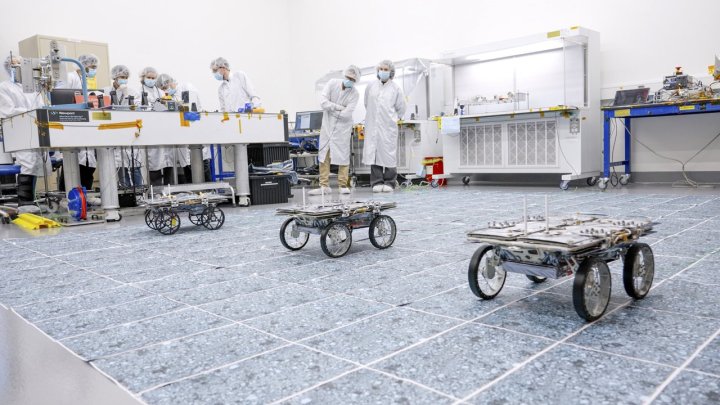NASA is ramping up its plans for exploring the moon, not only in terms of preparing to send astronauts there but also rovers. There’s the VIPER rover, which will search for water around the lunar south pole, and now NASA is introducing a trio of mini rovers called CADRE, or Cooperative Autonomous Distributed Robotic Exploration. These will work together as a team to map the lunar surface, testing the possibilities of using rovers in groups for future exploration.
The rovers, developed at NASA’s Jet Propulsion Laboratory, are just the size of a carry-on suitcase. They are designed to move independently but share data so they can cover more ground than a single rover could. They’ll have to work over a lunar day, which is about two weeks, to map out features on the surface and look below ground using radar.

But before the rovers can be launched, they have to undergo rigorous testing. “We have been in overdrive getting this tech demo ready for its lunar adventure,” said Subha Comandur, CADRE project manager at JPL, in a statement. It’s been months of nearly round-the-clock testing and sometimes re-testing, but the team’s hard work is paying off. Now we know these rovers are ready to show what a team of little space robots can accomplish together.”
Tests include simulating the vacuum of space and the high and low temperatures that the rovers will have to deal with during launch and on the moon. In addition, hardware can experience extreme vibrations during launch, so the rovers are tested by being strapped to a shaker table and intensely vibrated.
“This is what we submit our rovers to: ‘shake’ to simulate the rocket launch itself and ‘bake’ to simulate the extreme temperatures of space. It’s very nerve-wracking to witness in person,” said JPL’s Guy Zohar, the project’s flight system manager. “We’re using many carefully selected commercial parts on our project. We expect them to work, but we’re always a little worried when we go into testing. Happily, each test has ultimately been successful.”
Testing also involves getting the rovers to drive on a variety of surfaces, seeing if the group can maintain a formation even when there are challenges, like one rover with a low battery or slippery flooring to cover.
“Dealing with curveballs – that’s important for the autonomy. The key is the robots respond to things going off plan, then they replan and are still successful,” said JPL’s Jean-Pierre de la Croix, CADRE principal investigator and autonomy lead. “We’re going to a unique environment on the Moon, and there will, of course, be some unknowns. We’ve done our best to prepare for those by testing software and hardware together in various situations.”
The rovers are set to launch on the Intuitive Machines IM-3 mission to the moon, currently scheduled for early next year.
Editors' Recommendations
- Here are the new spacesuits astronauts will wear for tonight’s Starliner launch
- NASA’s Orion spacecraft has ‘critical issues’ with its heat shield, report finds
- NASA gives Starliner’s first crewed launch the go-ahead
- Junk from the ISS fell on a house in the U.S., NASA confirms
- SpaceX all set for a record-breaking rocket launch on Friday



